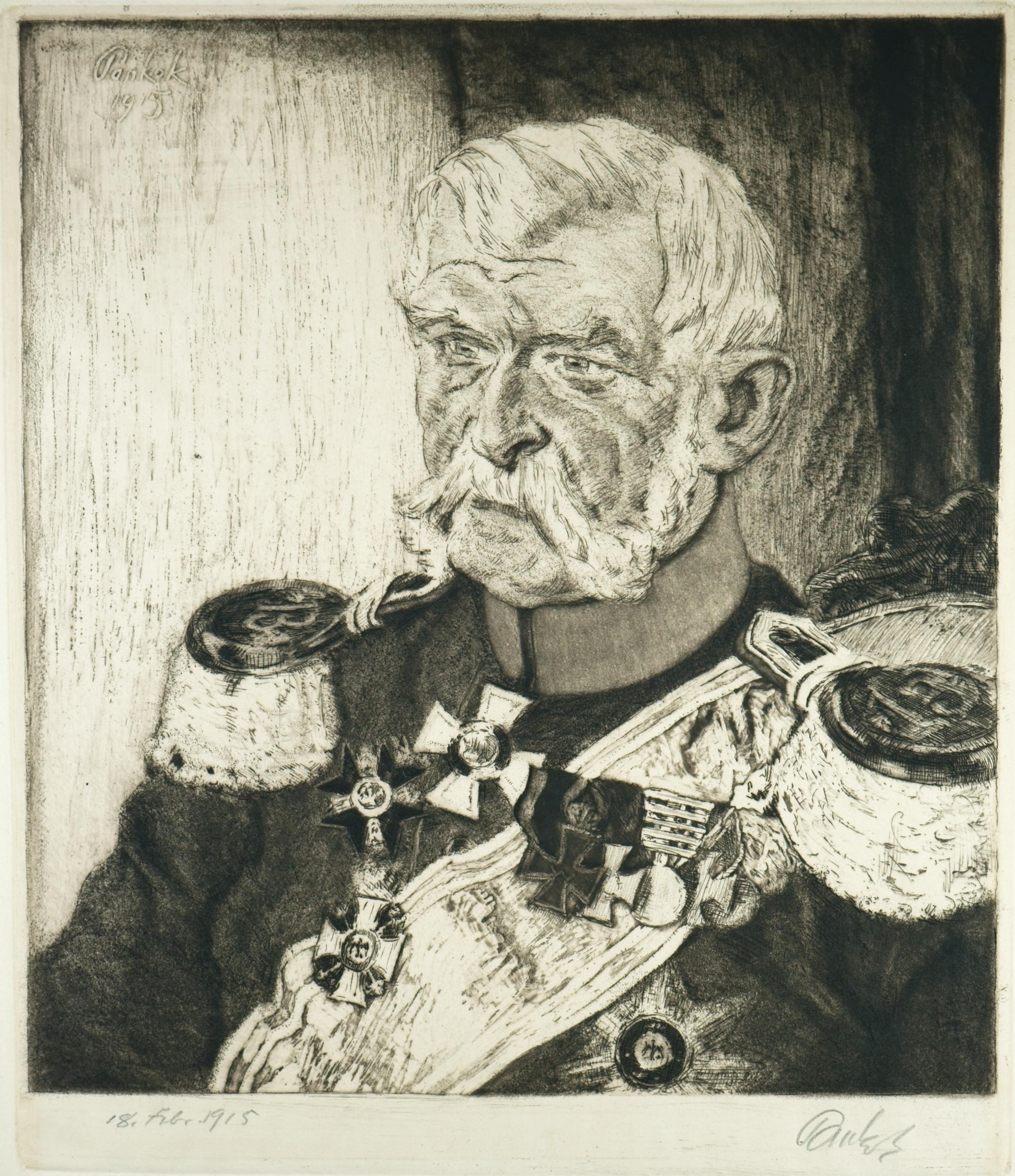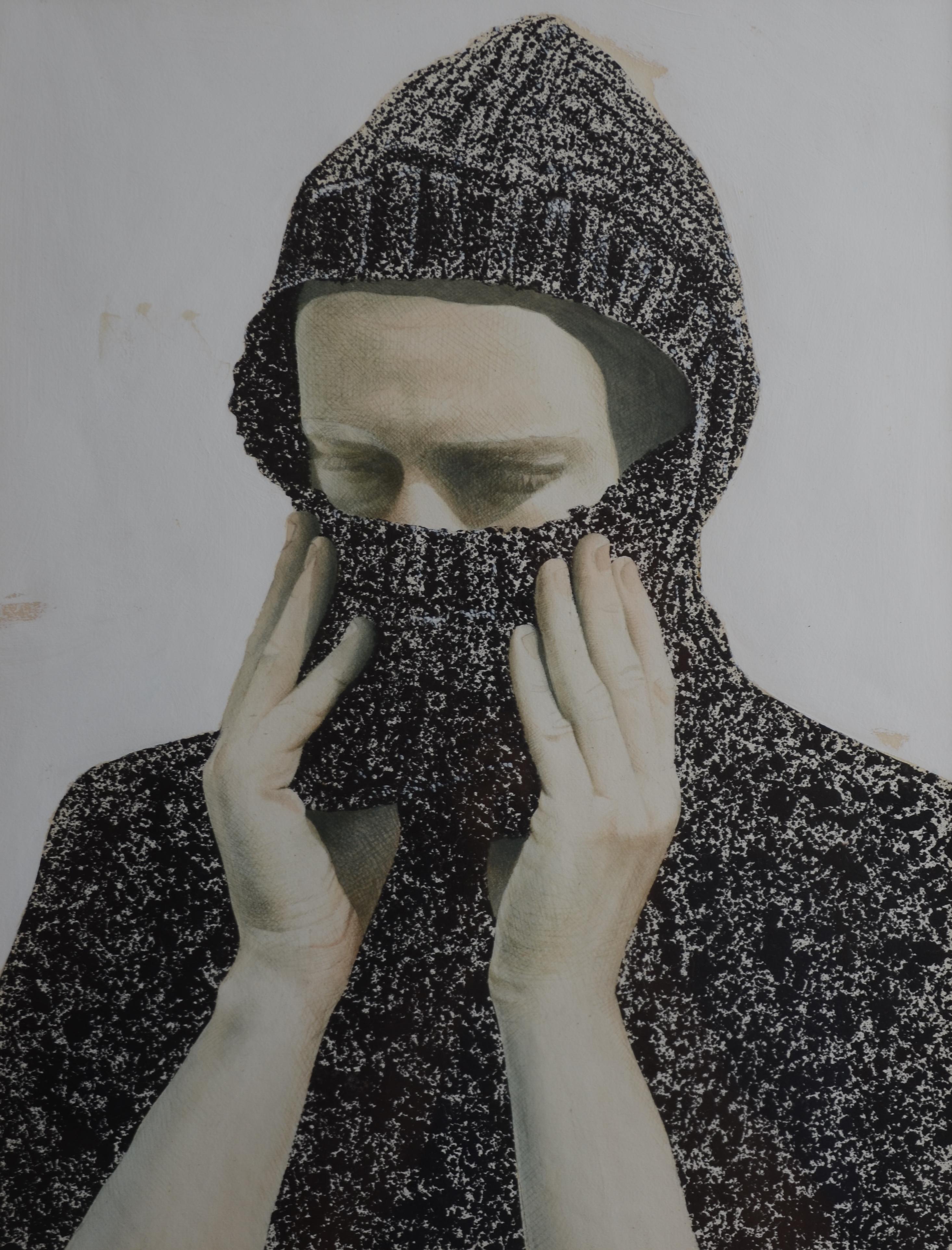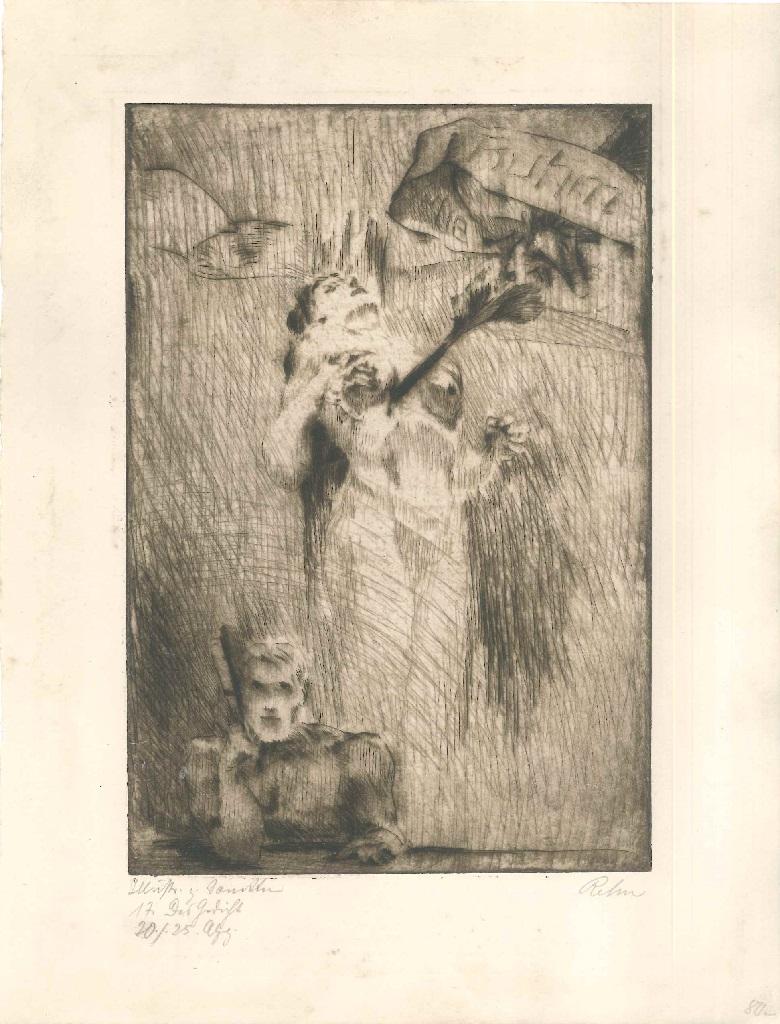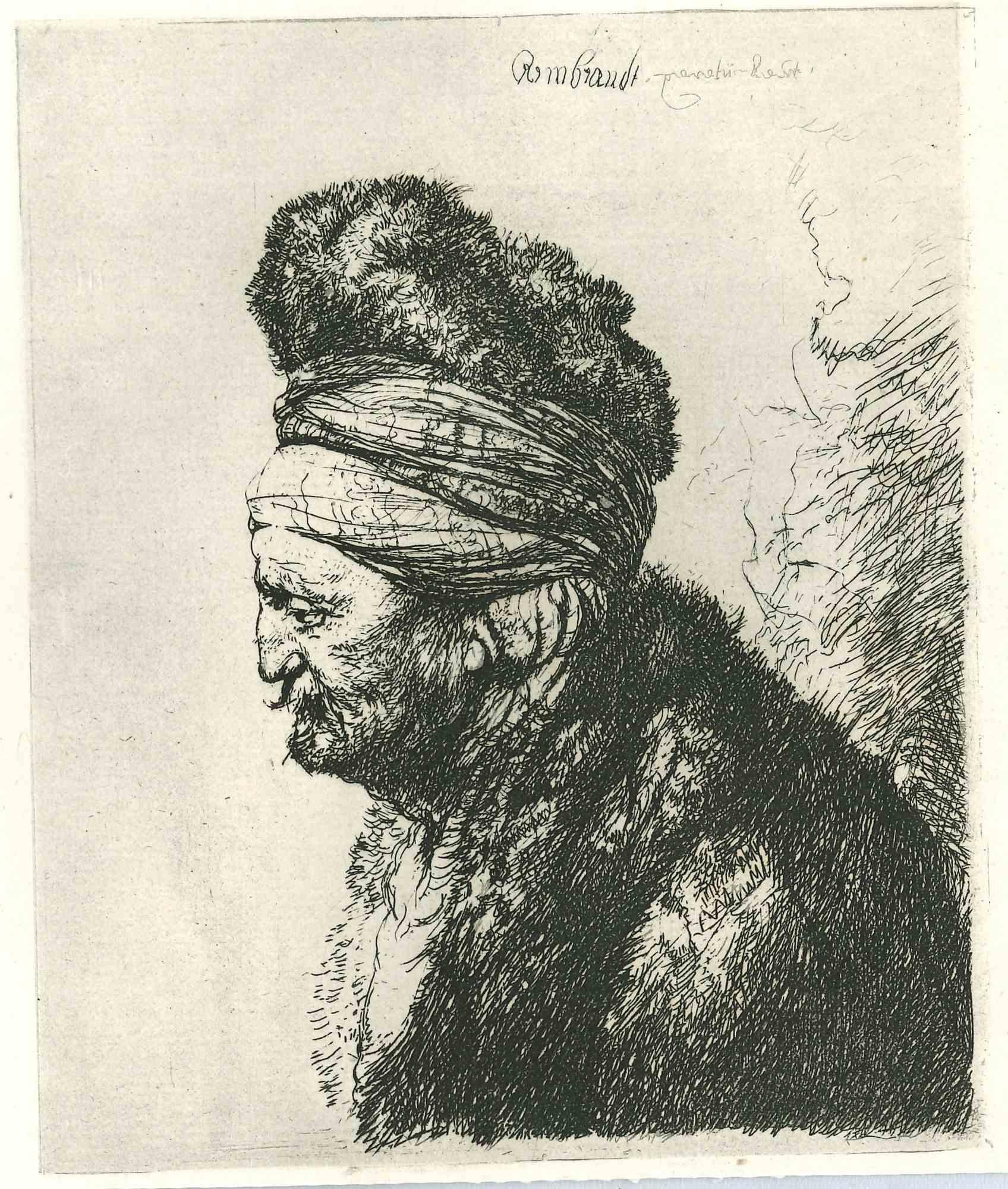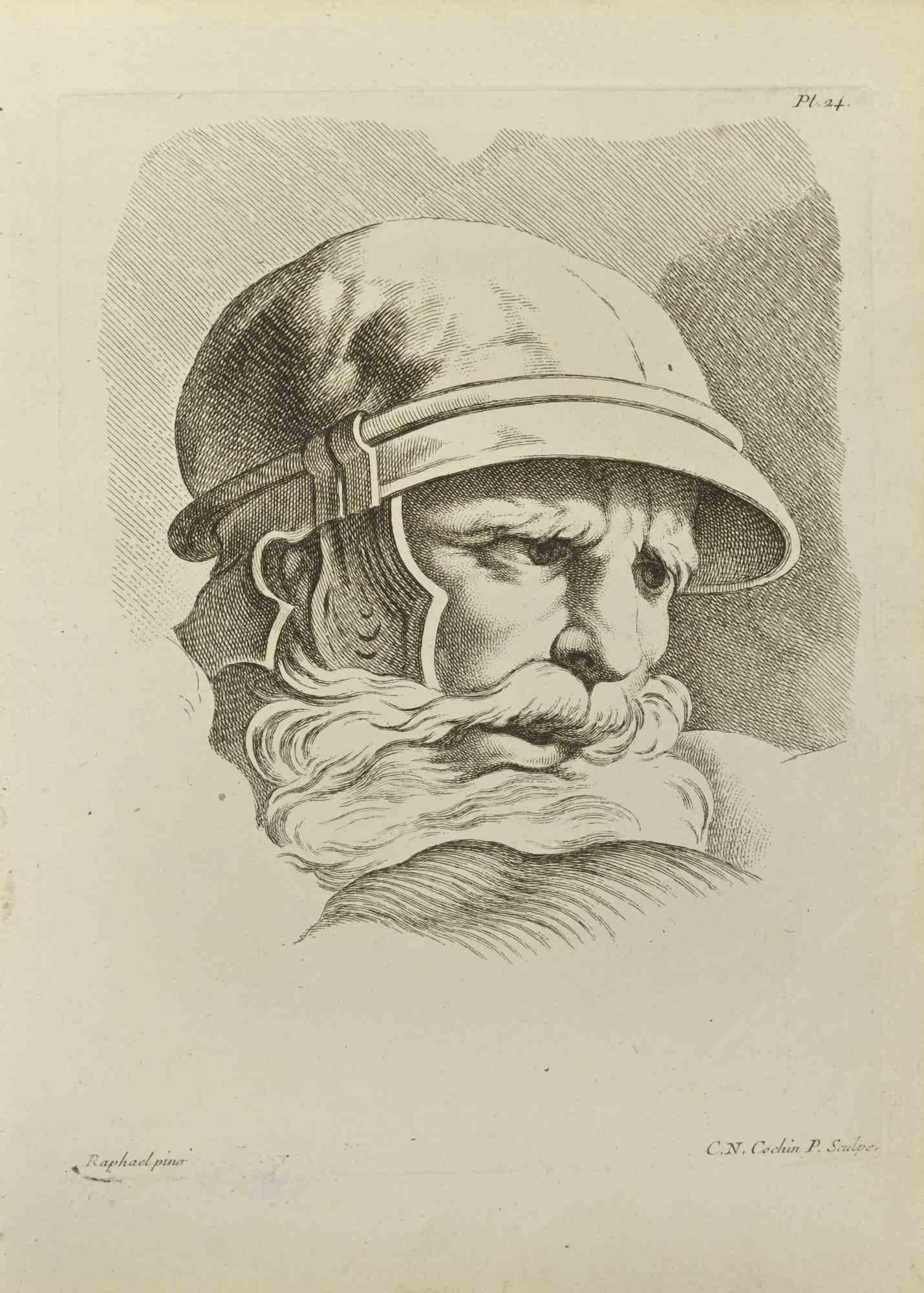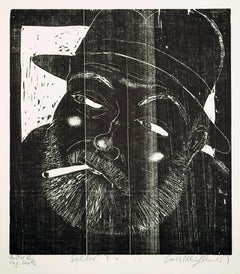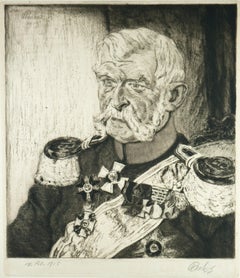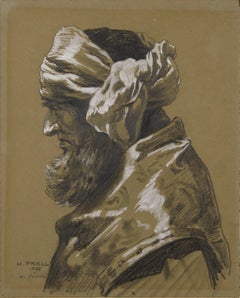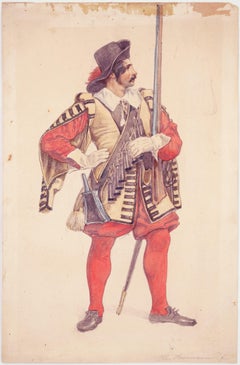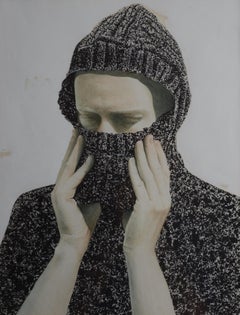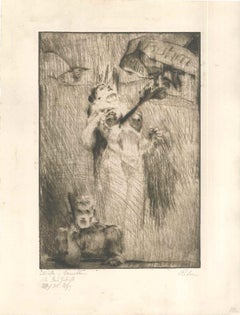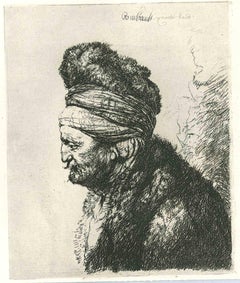Items Similar to Balaclava - The target in sight -
Want more images or videos?
Request additional images or videos from the seller
1 of 9
Heinrich HaberlBalaclava - The target in sight -c. 1900
c. 1900
$225.60
$28220% Off
£172.76
£215.9520% Off
€192
€24020% Off
CA$317.08
CA$396.3520% Off
A$347.82
A$434.7820% Off
CHF 181.99
CHF 227.4820% Off
MX$4,139.76
MX$5,174.7020% Off
NOK 2,298.58
NOK 2,873.2320% Off
SEK 2,156.11
SEK 2,695.1420% Off
DKK 1,462.64
DKK 1,828.3020% Off
About the Item
Heinrich Haberl (1869 Passau to 1934 Munich), Sturmhaube, c. 1900. drypoint, 14 x 10 cm (platemark), 28 x 21 cm (sheet size), 39 x 29 cm (passe-partout), titled "Sturmhaube" in lead at lower left and inscribed "Kaltnadelradierung", signed and locally inscribed "Heinrich Haberl Mchn. [Munich]" at lower right, inscribed again in lead on verso and with old collection stamp.
- slightly darkened, fixed and mounted
- The target in sight -
About the artwork
The theatrical "role-portrait" is to be seen against the background of the Rembrandt cult, which reached its climax at the end of the 19th century. The soldier seems to have stepped straight out of Rembrandt's Night Watch (1642) to fix something outside the picture with an alert and ready gaze. The steeply rising brim of the morion frames the gaze and thus perspectivises it as the actual 'pictorial action'. The gaze represents both the vigilant defence and the visionary goal of the battle.
Not only the subject, but also the style of the etching needle reflect Rembrandt's understanding of the times. Strong contrasts of light and dark are created in a virtuoso free stroke, without losing the effect of the reflections on the helmet and in the eyes. This shows a kinship with the early prints of Lovis Corinth, who also saw himself as an artist in the role of the knight. Against this background, Haberl's picture can also be seen as a representation of his artistic self-image.
About the artist
Heinrich Haberl first attended the art school in Nuremberg and from 1892 studied at the Munich Academy. There he was a master student of Johann Leonhard von Raab, Rudolf von Seitz, Franz von Defregger and Peter von Halm. From 1897 he supplied etchings to the Glass Palace in Munich and was represented at the Great Berlin Art Exhibition, the Dresden Art Exhibition and the Leipzig Book Trade Exhibition. Between 1902 and 1904 he worked as an illustrator for the magazine 'Jugend'.
Selected Bibliography
Thieme-Becker, Allgemeines Lexikon der bildenden Künstler, Bd. XV, Leipzig 1922, S 396.
Sauer, Allgemeines Künstler-Lexikon, Bd. 67, Berlin - New York, S. 81.
GERMAN VERSION
Heinrich Haberl (1869 Passau bis 1934 München), Sturmhaube, um 1900. Kaltnadelradierung, 14 x 10 cm (Plattenrand), 28 x 21 cm (Blattgröße), 39 x 29 cm (leinenüberzogenes Passepartout), links unten in Blei mit "Sturmhaube" betitelt und mit "Kaltnadelradierung" bezeichnet, rechts unten mit "Heinrich Haberl Mchn. [München]" handsigniert und ortsbezeichnet, verso nochmals in Blei bezeichnet und mit altem Sammlungsstempel.
- leicht nachgedunkelt und am Passepartout fixiert
- Das Ziel im Visier -
zum Kunstwerk
Das theatralische „Rollenporträt“ ist vor dem Hintergrund der am Ende des 19. Jahrhunderts kulminierenden Rembrandtverehrung zu sehen. Der Soldat scheint geradewegs der Nachtwache (1642) Rembrandts entstiegen zu sein, um mit wachem und bereitem Blick etwas außerhalb des Bildes zu fixieren. Dabei verleiht die steil nach oben zusammenlaufende Krempe des Morion dem Blick eine Rahmung, wodurch der Blick als eigentliche ‚Bildhandlung‘ perspektiviert wird. Der Blick steht gleichermaßen für die wachsame Verteidigung wie für das visionäre Ziel des Kampfes ein.
Nicht allein das Motiv, auch der Duktus der Radiernadel entspringt dem damaligen Rembrandtverständnis. In einer virtuos freien Strichführung werden starke Hell-Dunkel-Kontraste erzeugt, ohne dass dadurch die Wirkungen der Reflexe auf dem Helm und in den Augen verlorengehen würden. Hierin zeigt sich eine Verwandtschaft mit den frühen Grafiken von Lovis Corinth, der sich als Künstler ebenfalls in der Rolle des Ritters sieht. Vor diesem Hintergrund ist auch Haberls Bild als Darstellung seines künstlerischen Selbstverständnisses zu betrachten.
zum Künstler
Heinrich Haberl war zunächst an der Nürnberger Kunstschule und studierte ab 1892 an der Münchner Akademie. Dort war er Meisterschüler bei Johann Leonhard von Raab, Rudolf von Seitz, Franz von Defregger und Peter von Halm. Fortan in München ansässig, beschickte er ab 1897 den Münchner Glaspalast mit Radierungen und war auf der Großen Berliner Kunstausstellung, der Dresdner Kunstausstellung und der Leipziger Buchgewerbeausstellung vertreten. Zwischen 1902 und 1904 war er Illustrator der Zeitschrift ‚Jugend‘.
Auswahlbibliographie
Thieme-Becker, Allgemeines Lexikon der bildenden Künstler, Bd. XV, Leipzig 1922, S 396.
Sauer, Allgemeines Künstler-Lexikon, Bd. 67, Berlin – New York, S. 81.
- Creator:Heinrich Haberl (1869 - 1934, German)
- Creation Year:c. 1900
- Dimensions:Height: 15.36 in (39 cm)Width: 11.42 in (29 cm)Depth: 0.4 in (1 cm)
- Medium:
- Movement & Style:
- Period:
- Condition:
- Gallery Location:Berlin, DE
- Reference Number:1stDibs: LU2438212338412
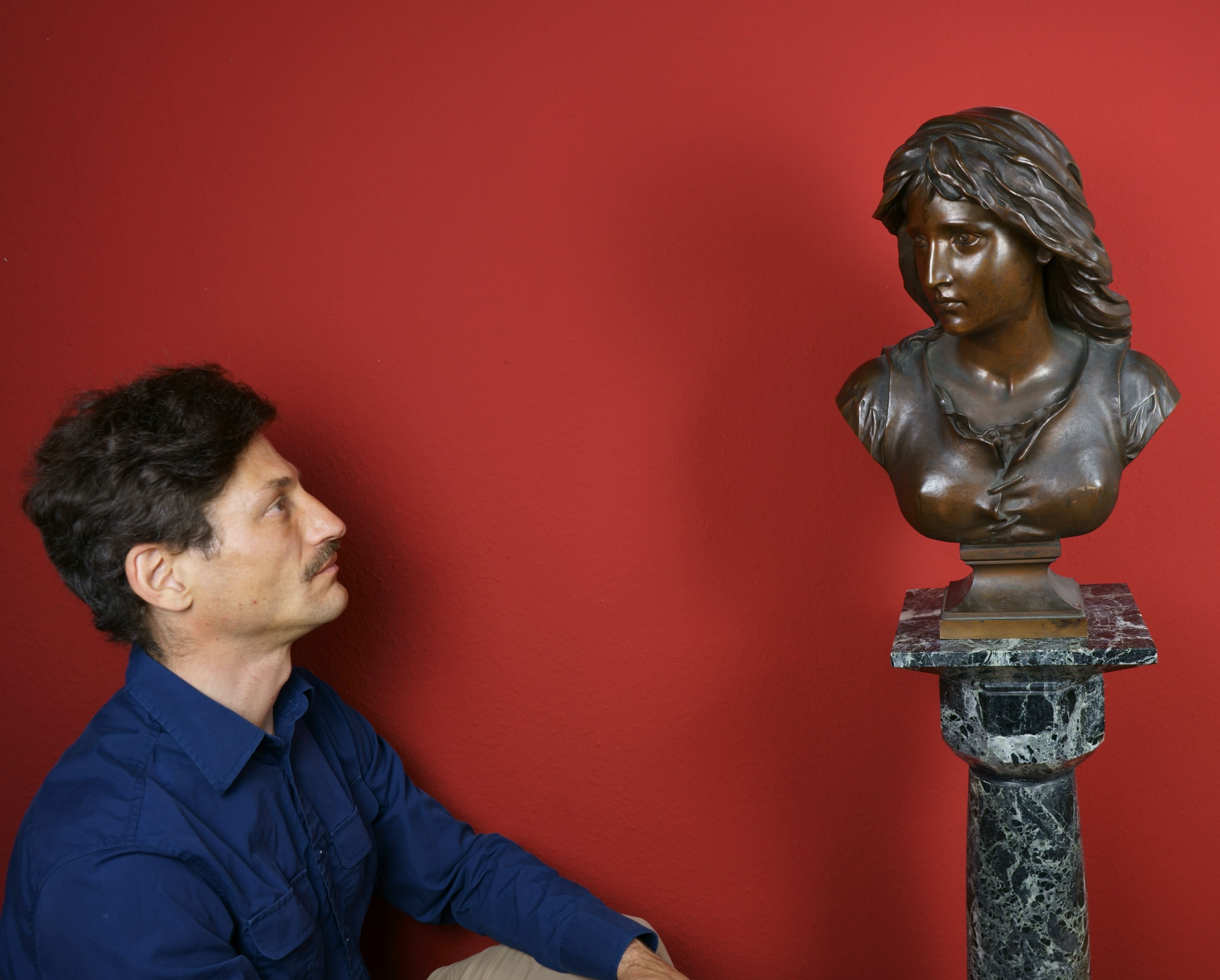
About the Seller
5.0
Vetted Professional Seller
Every seller passes strict standards for authenticity and reliability
Established in 2014
1stDibs seller since 2023
22 sales on 1stDibs
- ShippingRetrieving quote...Shipping from: Berlin, Germany
- Return Policy
More From This Seller
View AllSelf / - Inversion -
Located in Berlin, DE
Kurt Mühlenhaupt (1921 Klein Ziescht - 2006 Berlin), Myself, c. 1975. Woodcut, 32 cm x 29 cm (image), 36.5 cm x 32.5 cm (sheet size), signed in pencil lower right and titled “Selbst....
Category
1970s Realist Figurative Prints
Materials
Paper
$263 Sale Price
20% Off
General Wilhelm von Blume - Visionary retrospective -
Located in Berlin, DE
Bernhard Pankok (1872 Münster - 1943 Baierbrunn), General Wilhelm von Blume, 1915, aquatint etching, 34 x 29.5 cm (sheet size), 26 x 22 cm (plate size), signed in the plate at upper left, in pencil at lower right and dated in pencil at lower left.
- At lower left old collection stamp, at the right broad margin with a small spot, otherwise very good condition.
About the artwork
The 1915 aquatint etching of General Wilhelm von Blume is based on a 1912 oil painting in the LWL-Museum für Kunst und Kultur in Münster. A second oil portrait of the general by Pankok is in the Staatsgalerie Stuttgart. When Pankok painted the first oil portrait in 1912, the general had already been retired for 16 years. It is therefore a retrospective portrait. Accordingly, the orientation of his head is such that he is looking back in both the oil painting and the etching. Without fixing on anything in particular, he looks thoughtfully inwards and reflects on his life. Uniformed and highly endowed, it is his military activities in particular that he is reviewing attentively and, as his gaze reveals, quite critically.
Pankok has literally written the sum of his experiences on Wilhelm von Blume's face: The physiognomy is a veritable landscape of folds, furrows, ridges and gullies, all the more striking against the flat background. It is clear that each of the medals was also won through suffering. However, by breaking the boundaries of the picture, his bust appears as an unshakable massif, which gives the general a stoic quality.
The fact that the design of the portrait was important to Pankok can be seen from the different versions, the present sheet being the third and probably final revision, which Pankok dates precisely to 18 February 1915. Compared with the previous state, the light background now has a dark area against which the sitter's face stands out, the dark background in turn combining with the uniform to create a new tension in the picture.
Pankok's taking up of the portrait of the high-ranking military veteran and its graphic reproduction can also be seen in relation to the First World War, which had broken out in the meantime. In the face of modern weapons of mass destruction, Wilhelm von Blume's warfare and military writings were relics of a bygone, more value-oriented era.
About the artist
After studying at the Düsseldorf Art Academy from 1889 to 1891 under Heinrich Lauenstein, Adolf Schill, Hugo Crola, and Peter Janssen the Elder, Bernhard Pankok went to Munich in 1892, where he worked primarily as a graphic artist for the two major Jugendstil magazines "Pan" and "Jugend," which established his artistic success. Through this work he met Emil Orlik, with whom he had a lifelong friendship.
In 1897, he exhibited his first furniture, and in 1898, together with Richard Riemerschmid, Bruno Paul and Hermann Obrist...
Category
1910s Realist Portrait Prints
Materials
Etching
$451 Sale Price
20% Off
Half-length portrait of a Pharisee - In the shadow of betrayal -
Located in Berlin, DE
Hermann Prell (1854 Leipzig - 1922 Dresden-Loschwitz). Half-length portrait of a Pharisee, 1885. Sketch for the right-hand figure in the painting Judas Iscariot, 1886. Pencil drawing heightened with opaque white and black chalk on beige-grey wove paper (papier vélin), 34 x 27.8 cm (visible size), 52 x 45 cm (mount), signed, dated and inscribed "H. PRELL 1885 zu 'Judas'".
Minor browning, collection stamp on the reverse.
- In the shadow of betrayal -
About the artwork
This painting is the sketch for the head of the Pharisee offering the coins to Judas in one of Herrmann Prell's major works, the painting Betrayal of Judas, completed in 1886. The painting belongs to the Staatliche Kunstsammlungen Dresden and is illustrated in Adolf Rosenberg: Prell, Bielefeld and Leipzig 1901, p. 21 (Fig. 19). It is especially highlighted in Thieme-Becker (vol. 27, p. 376).
Hermann Prell, Betrayal of Judas, 1886
The monumental head, which fills the picture and is distinguished by its ornamented robe, is almost a lost profile, which in the executed painting is justified by the Pharisee's turning towards Judas. Despite the fact that the sitter withdraws from the viewer by turning away, it was necessary to artistically elaborate the motivation for the purchase of one of Christ's disciples, which is why the drawing focuses on the expression of the face, while the 'accessories' are treated in a more summary manner.
In characterising the face, Hermann Prell performs a balancing act: since the Pharisee, despite his destructive actions, is an actor in the history of salvation, the head must show a dignity appropriate to the event, but at the same time the physiognomy must also bear witness to the scheming attitude that led to the betrayal. To solve this dilemma, Prell draws on the traditional depictions of the heads of the apostles, shading the face to indicate the obdurate darkness of the spirit and moving the base of the nose slightly upwards while the mouth falls away, thus giving a physiognomic expression to the motivation of the action. The fatal drama of the betrayal is expressed in the monumentalisation of the head and in the thunderous white highlights that contrast with the darkness of the chalk.
As a study, considered by the artist to be a work in itself, this drawing reveals the pictorial problems and brainstorming of monumental painting.
About the artist
In 1872 Prell, who was one of the most important exponents of monumental painting of his time, began studying painting with Theodor Grosse at the Dresden Academy of Art and continued with Carl Gussow at the Berlin Academy in 1876. Hans von Marées taught him in Rome in 1878. More influential on his work, however, were Arnold Böcklin and Max Klinger, with whom Prell had been friends since his student days and with whom he worked together on several occasions.
Prell's first major work, which established his reputation as a monumental painter, were the frescoes in the banqueting hall of the Architektenhaus in Berlin in 1881/82, commissioned by the state and depicting the different periods of architecture. Prell then went to Italy for two years to study fresco painting. Other major commissions followed. These included monumental frescoes in the town halls of Worms (1884), Hildesheim (1882-92), Gdansk (1895) and Dresden, the staircase of the Silesian Museum of Fine Arts in Breslau (1893/94), the throne room of the German Embassy in Rome (1896-99) and the staircase of the Albertinum in Dresden (1900-1904).
From 1886 Prell taught at the academy of arts in Berlin and in 1892 he was appointed professor at the academy of arts in Dresden. His students included Osmar Schindler and Hans Unger...
Category
1880s Realist Figurative Drawings and Watercolors
Materials
Chalk
$1,410 Sale Price
20% Off
The actor Karl Seydelmann as soldier / - The expressiveness of a simple pose -
Located in Berlin, DE
Theodor Hosemann (1807 Brandenburg - 1875 Berlin), The actor Karl Seydelmann as soldier, around 1840. Watercolor in pencil, 22 cm (height) x 14.7 cm (width), signed “Th.[eodor] Hosem...
Category
1840s Realist Figurative Drawings and Watercolors
Materials
Paper
The actor Karl Seydelmann, probably as Max Piccolomini / - Theatrical Realism -
Located in Berlin, DE
Theodor Hosemann (1807 Brandenburg - 1875 Berlin), The actor Karl Seydelmann probably as Max Piccolomini, around 1840. Watercolor with pencil, 20.5 cm (height) x 14.7 cm (width), sig...
Category
1840s Realist Figurative Drawings and Watercolors
Materials
Paper
The Hut / - The head of the hat -
By Reiner Schwarz
Located in Berlin, DE
Reiner Schwarz (*1940 Hirschberg), The Hut, 1967. Lithograph, 32.5 cm x 32.5 (depiction), 59 cm x 42 cm (sheet size), signed “R.[einer] Schwarz” in pencil lower right, dated “[19]67”...
Category
1960s Surrealist Figurative Prints
Materials
Paper
$206 Sale Price
20% Off
You May Also Like
Balaclava, Contemporary British Artist, 1978
By Graham Dean
Located in London, GB
Graham Dean
1978
Balaclava
Coloured pencil and gouache
Image size: 16 x 12 inches
Self-portrait of the artist.
Category
21st Century and Contemporary Contemporary Paintings
Materials
Gouache, Pencil
Mein Weg mit dem Weib, plate 7
By Walter Richard Rehn
Located in Roma, IT
Drypoint and aquatint (brown ink) on cream paper.
Signed in pencil on the lower right margin. Titled and numbered in pencil on the lower left margin. Edition of 25 prints. From the s...
Category
1910s Modern Figurative Prints
Materials
Aquatint, Drypoint
Head of a Man with Turban - Engraving after Rembrandt - 19th Century
By Charles Amand Durand
Located in Roma, IT
Head of a Man with Turban is an engraving on ivory-colored paper realized by Charles Amand Durand (1831-1905) after an etching by Rembrandt. This wonde...
Category
19th Century Old Masters Figurative Prints
Materials
Engraving
Portrait after Raphael - Etching by Nicholas Cochin - 1755
Located in Roma, IT
Portrait after Raphael is an etching realized by Nicholas Cochin in 1755.
Signed in the plate.
Good conditions with foxing and folding.
The artwork is depicted through confident s...
Category
1750s Modern Figurative Prints
Materials
Etching
The First Oriental Head - Engraving after Rembrandt - 19th Century
By Charles Amand Durand
Located in Roma, IT
The First Oriental Head is an engraving on ivory-colored paper realized by Charles Amand Durand after an etching by Rembrandt dated 1635. This wonderful piece of art belongs to an ed...
Category
19th Century Old Masters Figurative Prints
Materials
Engraving
Faces and masks. Black and white print, Figurative, Polish artist
By Franciszek Bunsch
Located in Warsaw, PL
Black and white with figurative woodcut print by Polish artist Franciszek Bunsch. Print comes from limited edition, it is numbered and signed by the artist.
FRANCISZEK BUNSCH (1926...
Category
Early 2000s Other Art Style Figurative Prints
Materials
Woodcut, Paper
$263 Sale Price
20% Off
More Ways To Browse
Kaws Poster
Library Posters
Lucian Freud Etching
Maryan Pinchas
Montreux Jazz Festival
Nike Sneakers
Picasso Hibou
Plato Dialogues
Richard Gilbert
Richard Strauss
Roman Polanski
Salvador Dali Horse
Saul Steinberg On Sale
Shinsui Ito
Signed Print Leroy Neiman
Toulouse Lautrec Original Print
Vintage 70S T Shirts
Vintage Celebrity Posters

